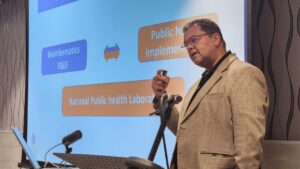Thanks to the Bill and Melinda Gates Foundation, PHA4GE received funds that were utilized to implement standardized bioinformatics practices, pipelines, and data structures in either anti-microbial resistance (AMR) or SARS-CoV-2 sequencing within national public health laboratories. We look at six teams, from five different low to middle income countries (LMICs), that successfully completed these projects.
PHA4GE chats to Dr Koen Vandelannoote from the Institut Pasteur du Cambodge, Cambodia. They share on what worked well, what could have been done differently and what they envision as next steps in being responsive to disease outbreaks.
Dr Vandelannoote, what worked well in implementing the AMR project?
The Medical Laboratory of the Institut Pasteur du Cambodge (IPC) has been working with partnering institutions to build genomic AMR surveillance capacity for Cambodia. We have been exploring various bioinformatic pipelines capable of analyzing genomic AMR data in an interoperable manner. An awarded PHA4GE sub-grant supported us in exploring the PHA4GE AMR gene detection output standard for exchanging AMR genomic surveillance results between IPC and the Microbiological Diagnostic Unit Public Health Laboratory (MDU PHL) at the Peter Doherty Institute, who have implemented pathogen genomics for public health in the state of Victoria (Australia).
In your own opinion, what did not work well and how could this have been done differently?
We didn’t experience any issues during the installation / implementation of hAMRonization and successfully performed a series of exchange exercises with MDU-PHL. During these exercises we didn’t identify any discrepant results. We did notify the developers of a number of minor points that could be better described in the hAMRonization documentation.
What are the next steps for you and your team?
We plan to continue using hAMRonization when comparing output from different AMR gene detection tools during exchanges with other institutes.
Dr Koen Vandelannoote worked with Rutaiwan Dusadeepong, Gauthier Delvallez, Kristy Horan, Tuyet Hoang and Tim Stinear to complete this project.



